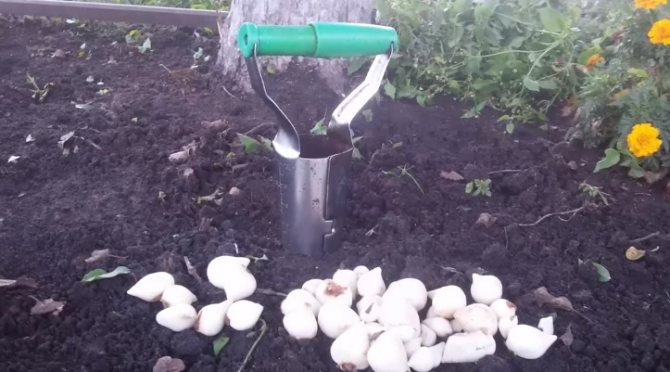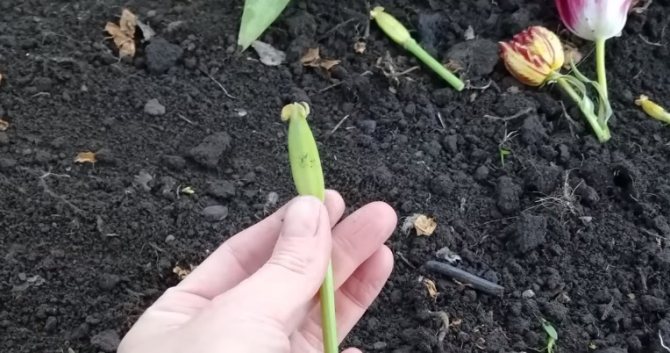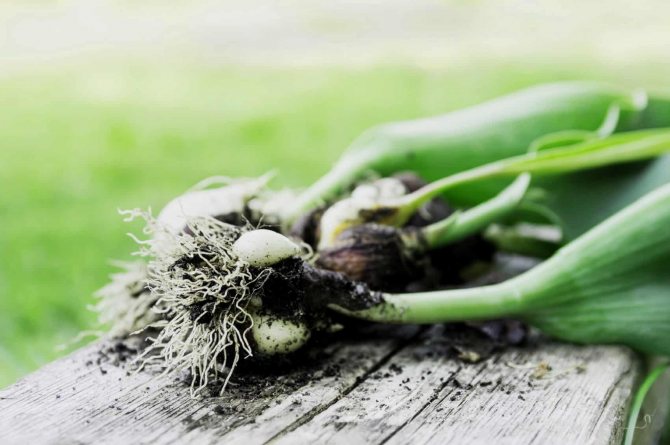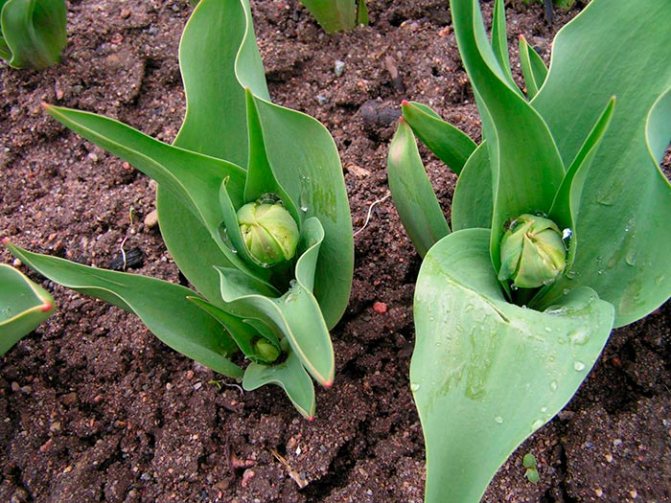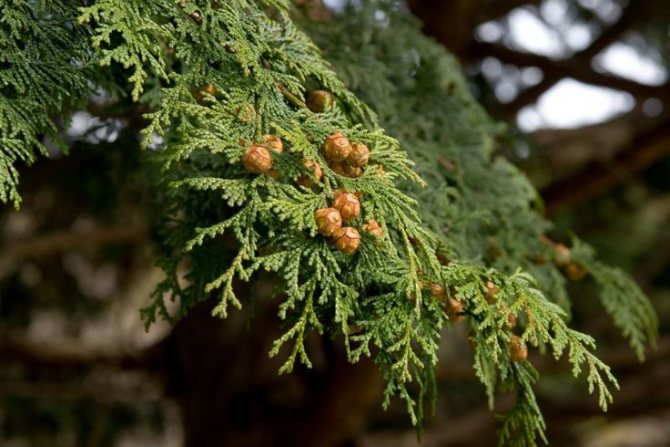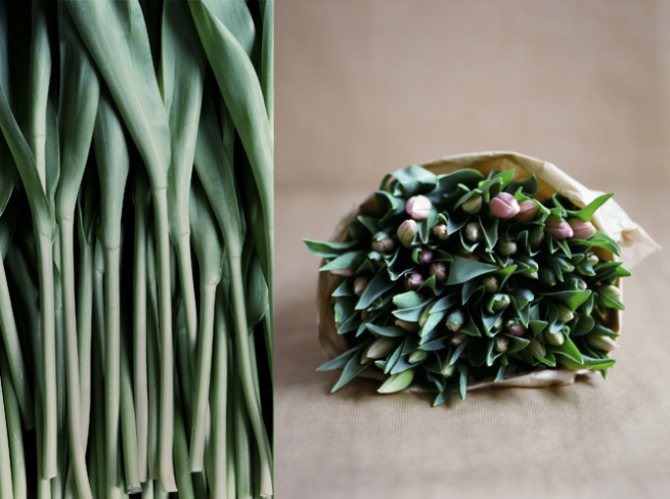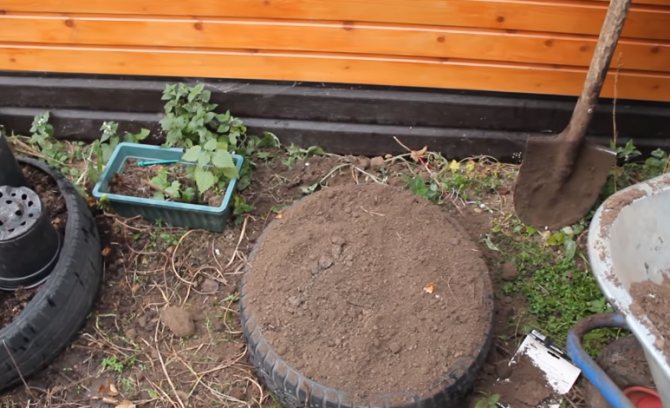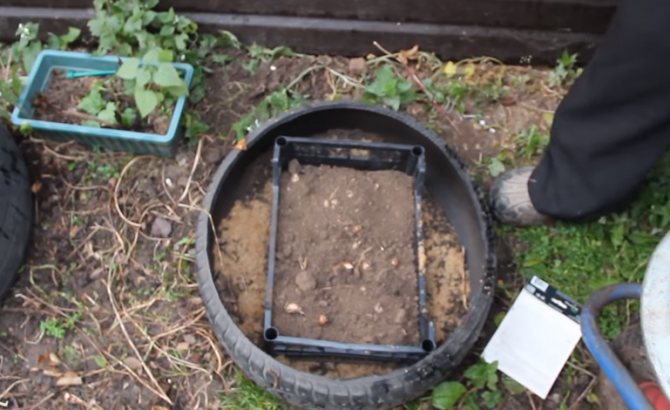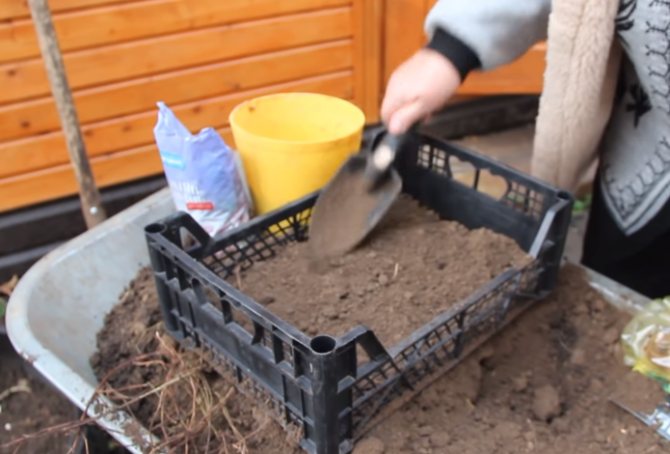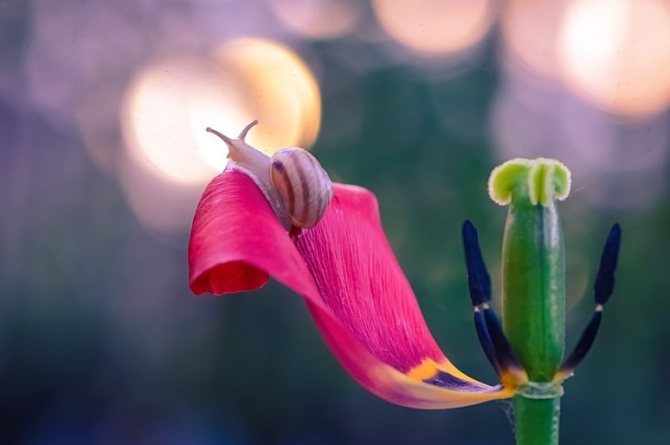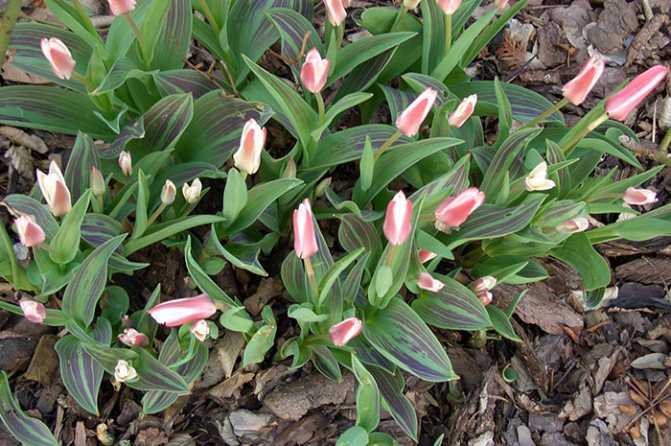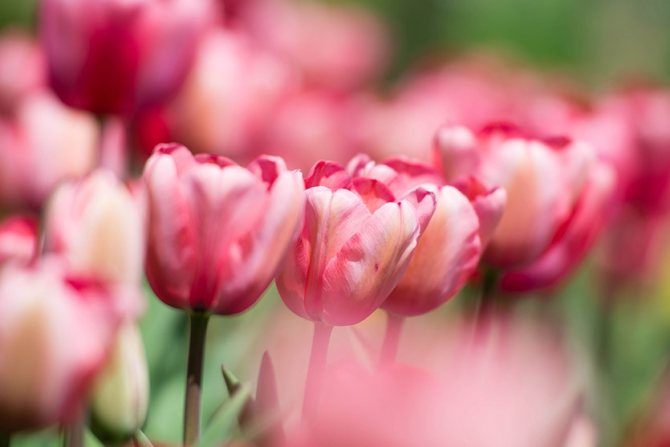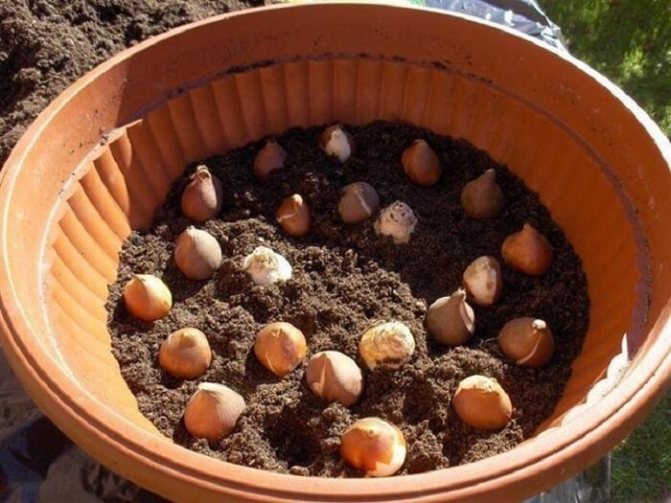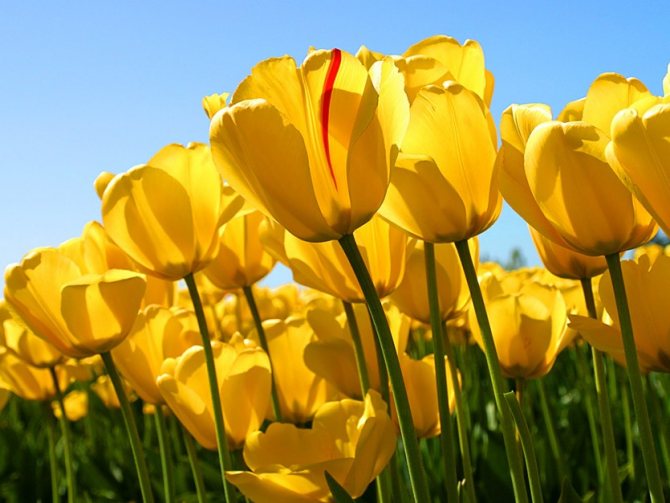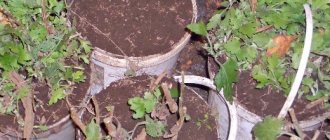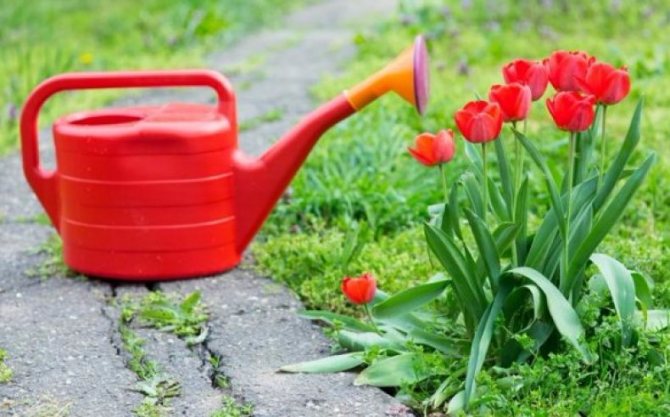
Often, gardeners have problems with tulips. For example, flowers planted before winter grow, but do not bloom. Or tulips that have bloomed magnificently in the past year do not sprout at all the next year. In order for a flower bed to annually delight with a riot of bright colors of pampered buds, you need to know how to care for tulips after flowering. And in this article we will reveal a few secrets for the correct planting and caring for bulbs.
How to care for tulips after flowering
Do you need to cut the leaves?
Daffodils and tulips are often planted side by side in a flower bed to create a picturesque picture. However, their neighborhood has one caveat. It consists in the fact that faded buds and yellowed leaves quickly become unattractive. But take your time to rid your garden of unkempt stems. Caring for tulips after flowering should be continued for another 2-3 weeks. And so that dry leaves do not spoil the decorative look of the garden, just plant perennials between them. For example, phlox.
The foliage of plants is recommended to be preserved precisely because the sun's energy and useful microelements enter the bulb through it. They saturate the plant. Cutting off the still green leaves of tulips means stopping the bulb formation process. On faded specimens, it is better to immediately remove the seed capsule. So the bulb will be able to accumulate energy in itself and will not waste it on the ripening of the seeds.
Advice. In order not to lose the location of the tulips after the foliage dries, you can mark it with markers or flags.
Cut correctly
Fresh flowers are an important attribute in decorating a modern interior, because fresh flowers are a living energy in the house. But no matter how well the flowers are processed by the florist after cutting, sooner or later they will wither.
Tulips are one of the first spring flowers to appear in our vases. Caring for cut tulips starts right from the cut of the flowers.
It is very important to choose ripe buds that have already reached their color, and also preferably heavy buds.
Why fertilize withering plants?
Caring for tulips after flowering requires timely fertilization. The point is that the development process is still ongoing. And the appearance of flowers in the next spring will depend on how much the gardener is not too lazy to water and feed the withering flower bed with special fertilizers. You need to water the flower bed as needed for another two weeks after cutting the peduncles. You only need to fertilize the soil once. This will be enough. You can pick up the usual mineral fertilizers for bulbous. But the dosage should be reduced by half of the recommended dosage in order to prevent chemical burns of cells. A phosphorus-potassium mixture is also well suited. Fertilizers containing nitrogen or chlorine must not be used.
Marketable condition
Manufacturers and sellers of flowers are very concerned about the observance of the rules for storing goods, because for them the appearance of plants is money, first of all. And the flowers will have not only the cutting procedure, but also stressful transportation to the points of sale, the agonizing expectation of their buyer sometimes for more than one day.Since the money spent should pay off, it means that the flowers must hold out for some more time in the consumer's vase, otherwise he will feel cheated by the buyer.


Experienced specialists carefully process the flowers with all kinds of means in order to keep their decent presentation for a longer time. We bring to our house not only killed plants, but also appropriately preserved ones. But even in this form, they manage to give us their amazing beauty, positive energy and enchanting aroma.
Cutting leaves
Care for daffodils, as close relatives, is required in late spring in the same way as caring for tulips after flowering. If all the gardener's actions at this time are lined up sequentially, then they will stand in the following order:
- flowers are cut to form bouquets or allowed to naturally wither;
- in the second case, the seed capsule is cut off after the petals fall;
- in the last days of spring, special fertilizers are applied to the soil, while not forgetting to water the garden;
- leaves are cut off only after drying;
- after the bed is mulched with peat or wood ash.
Add cold water
Caring for cut tulips involves pouring water into the vase frequently, as tulips are very fond of water. The air temperature is cool, but not cold, and a shaded place will allow you to enjoy the bouquet a little longer than if you expose them to the sun. But don't expect a long enough tulip bloom in a vase. Just a few days and the buds fully open, and after a couple of days they crumble.
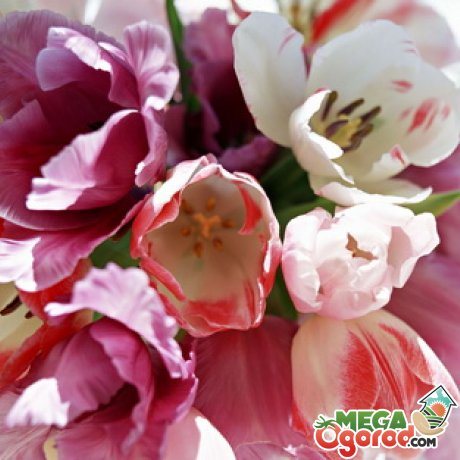

It does not hurt to add a few drops of potassium permanganate solution, a spoonful of vinegar, an aspirin tablet or activated carbon to a vase of water - all this is done with the aim of destroying bacteria in the water and preventing the development of putrefactive microorganisms. Withered tulips are renewed, the plants are wrapped in paper and immersed in cold water with ice until the buds. For greater effect, you can wrap the container with a cloth or plastic wrap for several hours.
When should you transplant daffodils?


These flowers can live in one place for up to five years. Do not disturb them for an annual transplant, otherwise the plants may not bloom so abundantly. But if the stems begin to get crowded and have grown quite a lot, then it's time to plant them.
For a transplant, you will need:
- garden shovel;
- gloves;
- disinfecting solution.
Daffodil bushes are planted right away; young roots should not be allowed to dry out. Pick a late afternoon in early August, when the midday heat has subsided, and get started.
What do we have to do?
1) To begin with, the bushes are carefully dug up.
2) Then they are divided into smaller ones and laid out for processing.
3) For prevention, plants can be sprayed with a weak solution of potassium permanganate or a suitable fungicide.
4) In a new place, the holes are prepared and daffodils are transplanted into them with maximum accuracy.
Watering and feeding faded tulips
Within 10-14 days, after flowering, we water the bed intensively, we help the bulbs to intensify the work of accumulating useful ingredients from the soil. If it is depleted, it is necessary to feed.
Tulips like fertile, loose soil, so do not give up the annual application of humus and wood ash. But when after flowering comes a dormant period, mineral fertilizers will not interfere with planting.
They should contain phosphorus, potassium, nitrogen, manganese, iron, boron, zinc - all the elements necessary for respiration, growth, nutrition. Make sure that nitrogen in the list is in small doses, its increased values are needed exclusively before and during flowering.
When are tulip bulbs dug up?
Unlike daffodils, tulip care after flowering is required annually.If you want large flowers to bloom in the spring, plan to dig out the bulbs annually. This is best done in the middle of summer, when the leaves are completely dry. Try to dig one and see how it looks. If it is covered with brown scales, the roots have formed, the stems have practically dried up, then it's time to dig up the entire flower bed.
Caring for tulips after flowering in the garden is pretty simple. You just need:
- carton boxes;
- leaflets with inscriptions of varieties;
- garden shovel;
- gloves.
What do we have to do?
- choose a not too cloudy day in early July;
- prepare the necessary inventory;
- carefully dig up the plants, treat them with a disinfecting solution and arrange them by variety in cardboard boxes;
- discard all weak and small bulbs.
Thus, the summer care of tulips after flowering in the garden can be considered complete. Plants will be dormant for one and a half to two months before planting.
Digging up the bulbs and preparing for storage
By the end of June - the first half of July, the stems are completely dry. For those who decide to dig up tulips after flowering, it's time to do it.
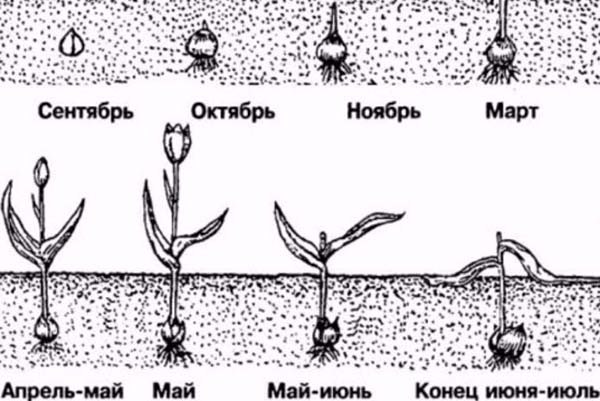

Scheme "Life cycle of tulips"
Many growers argue about how often to remove the bulbs from the soil. An important argument is the creation of a favorable temperature regime for the varietal properties of the future tulip. A temperature in the range of 23-25⁰ above freezing is extremely necessary for the bulbs for the next two months. On the territory of the Russian Federation, the soil is not able to warm up to such an extent. Therefore, the relevance of the annual digging of tulip bulbs on the face.
Another important reason for such a useful procedure is the disappearance of varietal traits and a reduction in the ability to reproduce tulips. It is the transplant that is able to sort out full-fledged bulbs and reject damaged and sick ones.
It is not enough just to know when to dig up tulips after flowering, you need to be able to properly store the bulbs for the next season. All bulbs should dry well within a week. A warm, dark and well-ventilated place is well suited for these purposes. After that, they begin breeding work, namely: they remove all the roots and damaged scales. The selection is based on the size of the bulbs. Damaged and diseased specimens are removed.
Tulips are stored for an average of 2 - 2.5 months before planting. During this period, it is important to create optimal conditions for laying a flower bud in the bulb. The temperature regime fluctuates within 23–25 ° C above zero, after a month it is reduced to 15–18 ° C above zero and a month later it is brought closer to the maximum natural temperature of 10–12 ° C above zero. The bulbs can be arranged in two layers. The condition of the scales should be monitored. Excessive drying will negatively affect future flowers.
When should you plant?
If you are planning the usual planting of flowers that will bloom in April-May, then a fine day in early September is suitable. Take all boxes of bulbs to the air, carefully review all material. If there are spoiled copies, they must be removed immediately. If you find diseased material, then it will not be superfluous to re-treat with a fungicide.
Find a new place to plant flowers. Proper care of tulips and daffodils after flowering involves a constant change in the location of the flower bed. This way you can avoid depleting the soil.
Planting material in the pits.
Loosen the soil and make indentations about half a spade in it. Spread the bulbs evenly and pour warm water over them. After two weeks, the garden can be fertilized with saltpeter. And with the onset of the first frost, its surface is covered with a layer of mulch (dry leaves, straw or peat).
Landing in trenches.
The place chosen for the flower garden is laid out and trenches are dug. Their depth should not exceed 20 cm, and their width - 25 cm. Before placing on the bottom of the bulb, sprinkle it with saltpeter. Next, the largest specimens are distributed and crushed with earth. Smaller ones are spread over them and sprinkled again. If you are planning to disembark children, then it is best to distribute them along the edges of the trench. Further, it is covered to the top with soil. After planting, the ridges are watered with water. Such post-flowering tulip care at home will certainly give good results.
In what water, what temperature is it better to put cut tulips: warm or cold?
A fresh bouquet is placed only in cold water (temperature - 4-6 ° С).
A bouquet is placed in warm water, which requires a kind of restorative complex:
- the stems of wilted flowers are pruned;
- flowers are wrapped in thick paper to align the stem;
- put together with paper in warm water (temperature is slightly above room temperature). In this case, the flower head should be above the water;
- after 1 hour, change the water to cold. Above the bouquet, a light source is installed, for example, an electric lamp. Leave the flowers under artificial light for 2-3 hours. This will help the flower heads move upward.
What to do if presented with a tulip in a pot?
Getting the symbol of spring in a pot at the end of winter is very nice. But what to do with the plant after wilting? Throw it away? Do not hurry. Timely caring for tulips after flowering in a pot will give the plant another chance. For this:
- water the flower all the time until it turns yellow completely;
- let the stems dry;
- when the bulb goes into a dormant period, it can be dug up;
- dry it and store it in a box until September;
- and in the fall, plant on the ridges along with the rest of the bulbs.
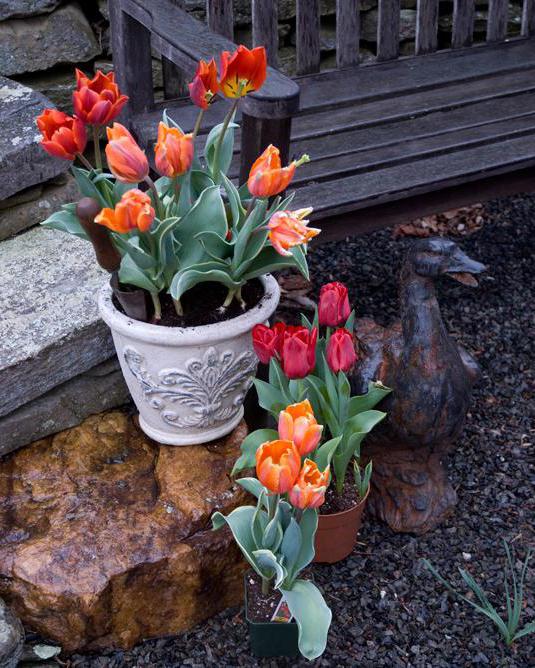

Flowers love care and appreciate attention. If you did everything right and worried about them from early spring to late autumn, they will definitely dissolve their delicate petals towards the sun. And they will delight you with their beauty.
Spring resounding marches rang out in the garden beds, bulbous crops, which so delighted flower growers after a long winter with bright flowers, completed their procession. The flowerbeds of faded tulips with drooping leaves look depressingly sad. Many try to plant annual seedlings in place of faded bulbous flowers as soon as possible.
But annual crops require frequent watering, which harms the bulbs that mature in the soil. It is too early to dig up the bulbs, not to dig them up is harmful to their development. This article is all about how to care for tulips after they bloom.
The fourth secret is the timely digging of the bulbs
The best time to dig up the bulbs is from early to mid-July. If the procedure is carried out too late, the nests and covering scales will begin to fall off, such bulbs will be poorly stored, and germination will be greatly affected.
Do the bulbs need to be dug out any year? No, this event does not have to be repeated every summer. It is enough to remove the bulbs once every two or three years.
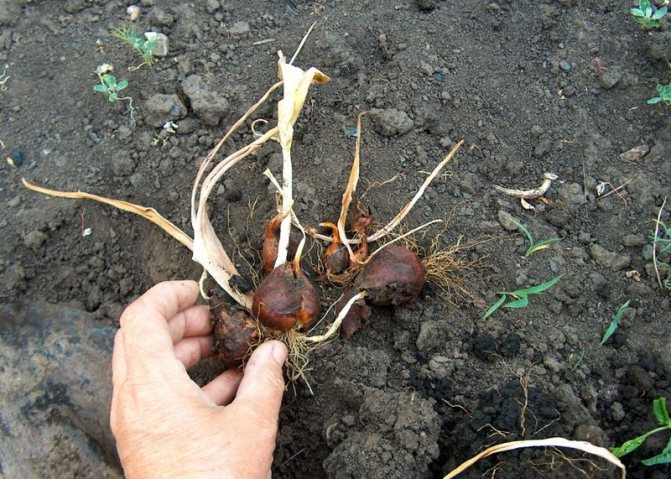

It costs any two or three years to dig up tulips.
What happens if you don't dig up the bulbs for decades? Tulip bulbs have the ability to sink into the ground every year. With any year, the bulbs will go deeper and deeper into the soil, and the moment will come when the sprouts will not be able to break through the thickness of the earth. This threatens the complete degeneration of tulips.
What to do if the bulb was damaged during the digging process, cut in two? It is necessary to dry it and carefully examine it. If the remaining part of the bulb and the bottom is preserved, it is worth leaving it and planting it in the ground together with the rest of the flowers in the fall. Rather, in total, such an onion will rise in the spring and give only a couple of green leaves. Throughout the season, the plant will accumulate nutrients in order to eventually form "babies" from a spoiled bulb.
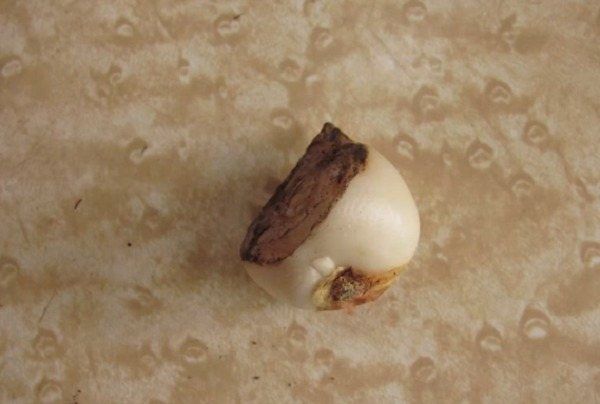

Damaged bulb, what else can germinate
If the bottom of the cut onion is not preserved, it remains only to send it to the compost heap or trash can.
June: what to do with tulips
After flowering, handsome men, droop and look untidy. But at this time, a replacement bulb and baby are formed in the ground. If during this period it is wrong to take care of the plantings, you can lose many varieties.
After the final wilting of flowers, it is necessary to remove all peduncles on the plants. They do not stop watering the plants for another 10-15 days. The top of the plants withers most quickly at high temperatures. Watering should not be stopped at this time, especially if the plants are with green leaves. You can not carry out frequent abundant watering, it is enough to keep the soil in a slightly moist state.
At this time, it is useful to carry out the last dressing, make phosphorus-potassium compounds at the rate of 30 g per 1 m2. It is strictly forbidden to use preparations with a high content of nitrogen and chlorine for feeding mature tulips.
Dry storage
Sufficient long-term storage provides cut tulips with a method of dry keeping them in conditions of low temperatures. For this, moistened paper is used, which is wrapped separately in several pieces of tulips so that their buds do not touch as much as possible.
The bundles are stacked on the shelves of the refrigerator, in which the temperature should not exceed three degrees Celsius with a high humidity of about 97%. The refrigerator should not contain fresh vegetables and fruits, the proximity of which, due to the ethylene emitted by them, is detrimental to flowers.
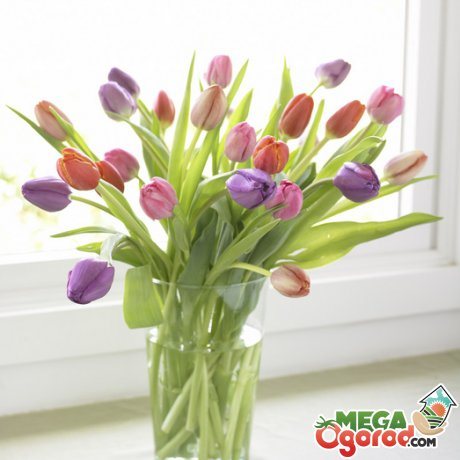

It is necessary to transfer tulips from the refrigerator to the room in stages to give time for adaptation. Then, without removing the wrapping material, put the tulips in cold water to restore the turgor of the plants, otherwise the stems will bend and bend. Only flowers that have drunk enough water can be released from packaging.
How to increase the decorativeness of a flower bed
When the aboveground part of the tulips withers, the process of growing bulbs continues underground, it is not recommended to water such beds abundantly. I would like to quickly bring the flower garden into proper form, increase the decorativeness of the flower beds, for which they often use portable containers with planted summer houses. It is not recommended to prune yellow leaves if they have not completely wilted, otherwise the process of the formation of the baby may completely stop. It is best to bend the leaves to the ground and cover them with decorative materials.
The soil around the pots can be mulched with colored bark or peat, which will not be difficult to remove when digging out tulips in the middle of summer.
In the period from late spring to the digging of the bulbs, the flower beds will regain their finished decorative appearance. Decorative garden figures can be placed on the mulch, which can be easily removed if necessary.
Looks great in a flowerpot on a leg geranium, petunia, lobelia, nasturtium, tuberous, arabis, ampelous forms of snapdragons, levkoi.
When watering containers, water from the drainage holes does not spread over the flower bed where tulips form the bulbs, so you can not be afraid of rotting of young bulbs and children.
Can tulips and daffodils be pruned after they have faded?
When the daffodils and tulips bloom, the peduncles can be cut off, and it is better not to touch the green leaves so that the bulbs have time to gain nutrients. The tulips can then be dug up to dry the bulbs and planted back in the ground before the frost begins. Then they will bloom next year.
Peduncles with set seeds must be cut off as soon as they bloom, so that nutrition goes to the formation of a good bulb and the plant does not waste energy on the ripening of unnecessary seeds. The sooner the flowers are trimmed, the larger the bulb will be.
Tulips can grow in one place for four years, and then they must be transplanted to another place.
If the bulb is left in the ground for two years, the flower will be larger. If longer, then they will stop blooming. Leaves do not need to be cut off, the onion feeds on them.
Once the tulips and daffodils have bloomed, you can cut the flower stalks to give the flower bed a well-groomed look. Leaves should not be cut off right away, let the bulbs pick up some nutrients for next year to bloom.
You can cut tulips and daffodils, when they have faded, I believe, only flower stalks. And I usually leave the leaves of tulips and daffodils until they dry up. I assume that the leaves of plants nourish the bulb, so it is better, in my opinion, not to remove them. And then next year these spring flowers will delight you again with abundant flowering.
As for tulips, I can say for sure that the flowers themselves must be cut off after flowering (or simply cut off with your hands), then the bulb will be strong and healthy. And the leaves of tulips are not cut off, because the onion feeds on them, and eventually ripens properly. The leaves will naturally droop. Someone digs up the tulip bulb itself for drying, and someone simply leaves it in the ground.
Daffodils are cut off after flowering completely, both flowers and leaves. Only then will the plant be ready for wintering, and the bulb will be strong, and the future plant itself will be just as healthy and pleasing to the eye of its owner.
Belated flowering is demonstrated by neighboring tulips in spring, and mine are almost ready to jump out of the snow. I just always knew that we had to dig them out every year, well, at least varieties and hybrids.
I'm not gloating, maybe they don't have enough time for flowers, maybe everything suits me, but it's more pleasant for me to contemplate the early arrows and lush buds. The riot of colors of the tulip meadow cheers up and confirms that these flowers are grateful for leaving.
I often hear the question of what to do with tulips after they have faded. Many gardeners, after the petals fall off, rush to quickly cut off the leaves to zero. Let's figure out why it is a bad idea to interfere with the natural course of things.
Advice! To camouflage fading tulips between the rows, you can place annual flowers or bring flowerpots on a leg, in which ampelous plants grow: petunia, lobelia, nasturtium.
When almost all the petals are dropped, you can cut off the head, but not the peduncle itself. The fact is that after flowering, seeds ripen in the bud, and all nutrition will be directed towards these needs, but we do not need this. What is more important for us is that certain processes begin in the bulbs.
There is an accumulation of nutrients for the next year and the laying of kidneys for future children. Therefore, the aboveground part of the plant is simply vital for the one that is underground. In general, tulips need more care after flowering, while they sit in the open field.
How not to lose your baby
If tulip bulbs are not dug out for several years, they go deep into the ground, are lost, deprived of the opportunity to germinate through a huge layer of soil. In order for the varietal baby not to be lost and the bulbs not to be buried, some measures must be taken since autumn.
In autumn, when planting tulips in the ground, you can use special containers with bottom holes that limit the growth of the baby. In the summer, you just need to dig up the container, not a single onion will be lost.
If many tulip bulbs are planted in the autumn months, the top layer of soil is chosen on the flower bed, a pit is dug (up to 20 cm deep), the bottom is lined with a plastic mesh for windows, bringing its ends to the surface. A layer of fertile soil is poured over the mesh and the tulip bulbs are laid out with an interval of 5 cm. After the tulips have bloomed and a dormant period, the mesh is pulled out of the ground, lifting all four corners at the same time.All tulips and the baby will remain in the mesh bag, will not be lost or injured by sharp instruments.
Secret six - protecting bulbs from mice
So that tulips and other bulbous civilizations do not suffer from rodent attacks during the winter, we recommend planting them in a special way in plastic trellised fruit baskets. In such boxes, all landings will be under reliable protection.
Step 1. Pour a layer of soil into the box with a scoop. You don't need to pour a lot, 3-5 cm is enough.
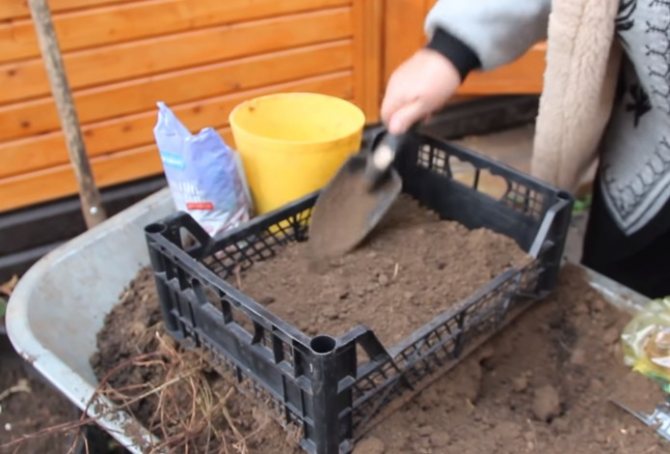

Backfill soil
Step 2. We take a package of granular fertilizer for paints and evenly sprinkle several granules on the ground.
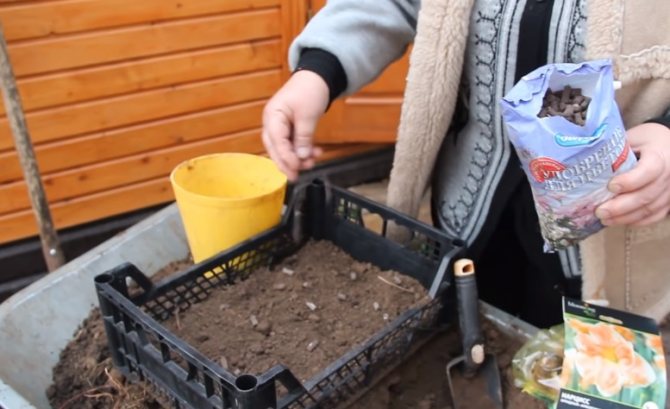

Fertilization
Step 3. The next layer is drainage. A thin layer of sand is necessary to prevent rotting of the bulbs.


Sand filling
Step 4. Place the bulbs carefully on the sand without pressing. You can distribute the bulbs as you like, in any schedule, but it is better not too rarely so that the flower bed is more lush.
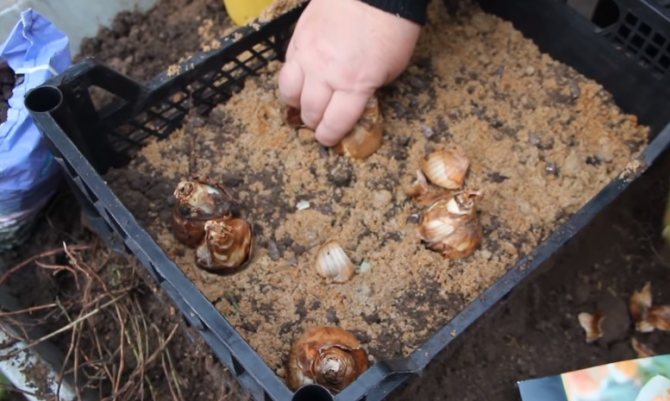

Stacking the bulbs
Step 5. We fill the box with soil to the very sides. We level the soil with a scoop.


Filling the box to the brim
Step 6. We install the box in the flower bed and fill it with soil. It remains only to wait for spring shoots.
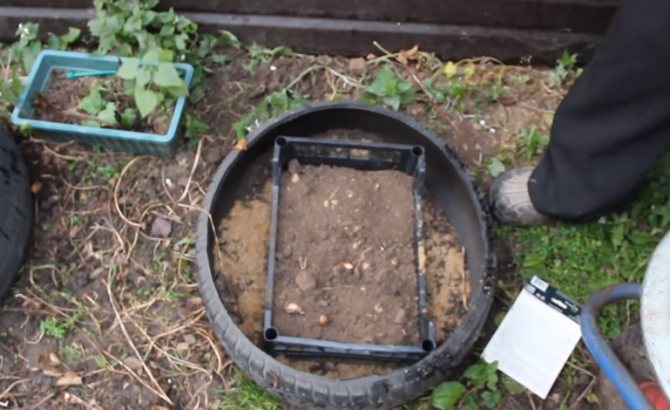

The box is placed in a flower bed


Backfilling flower beds
On a note! In the summer, when the tulips are blooming, you don't have to dig out a box, but plant seeds or seedlings of any annual flowers exactly on top.
When to start digging up the bulbs
You can start digging the bulbs only after the aerial part of the plants has thoroughly wilted, but it is best to carry out a trial operation by digging out several bulbs from different parts of the flower bed.
The scales of the bulb should be covered with dark brown spots and the baby should be fully developed. Mature bulbs show mature roots.
The basic rules should be followed:
- They start work on a sunny day, if it starts raining at the scheduled time for work, the work can be completed, but the bulbs are immediately washed and laid out for airing.
- You need to dig the ground carefully - remember that the nest with the baby can be at a considerable distance from the central stem.
- Particular attention should be paid to sick, rotten and mummified bulbs, such material is immediately disposed of and burned.
- Healthy bulbs are treated in a solution of potassium permanganate and dried. If there is a fear that the tulip bulbs are affected by rot, it is worth discarding the diseased bulbs and treating the planting material with preparations for rot and fungal infections.
- To preserve the varietal characteristics of tulips, it is worth digging them up annually.
Some more tips
Even an insignificant source of light will attract the attention of cut flowers, they will be drawn towards it, bending arbitrarily, and their crooked stems will look less aesthetically pleasing.
If the buds of purchased tulips are tied with elastic bands, it is most likely that the goods were sold expired - the flowers are overripe and will disintegrate without an aid.
When cutting tulips in your own dacha, you need to take care of the bulb remaining in the ground, which crushes and will be unsuitable for further development. The stems remaining after cutting should have at least a couple of leaves in order to maintain the vital activity of the bulb.
Tulips will stand longer, look really alive and become a stylish element of modern design if you put not cut flowers in transparent vases with water, but tulips along with bulbs taken out of the ground and well washed. This option is still more original and humane.
How to store bulbs until fall
After digging, the tulip bulbs are sorted according to varieties and parses, after which they are dried in partial shade in the air. To ensure that the tulip planting material is well preserved until the autumn planting, the bulbs are laid out in boxes with ventilation holes.
For about a month, the bulbs are dried at a temperature of 23-25 ° C, humidity up to 70% in rooms with good ventilation. Gradually, the storage temperature of the planting material is reduced:
- August
- set the temperature regime up to 20 ° C. - September
- the temperature is lowered to 15-17 ° C.
Compliance with the temperature regime is fundamental for the development of tulips for the next year, because flower buds and the formation of peduncles occur just in the last summer months.
Do not neglect the visual inspection of the bulbs, so you can immediately notice rotten and diseased specimens that must be immediately destroyed.
Already in September-October, tulips and the baby are again planted in the flower beds in the garden to enjoy the bright carpet of charming spring flowers grown from their own bulbs in early spring.
Providing proper care of tulips after flowering, you can get not only magnificent flowers in the coming season, but also additional bulbs - "children". Although such plants can be seen in almost every garden, not everyone knows how to grow them competently from the appearance of young shoots until the moment when all the buds wither and the stems dry out.
The fifth secret is the correct storage of bulbs
What to do with the bulbs immediately after digging up? It is necessary to separate clods of earth, tear off dry roots, without applying excessive force. If the roots are difficult to pull off, it is best to leave the bulb in a dry place for three days and then try again.
The dug out bulbs must be dried for several days. To do this, they can be laid in trellised fruit crates or laid out in one layer on newspapers, film. When the bulbs are dry, it is imperative to remove the old covering scales from them.
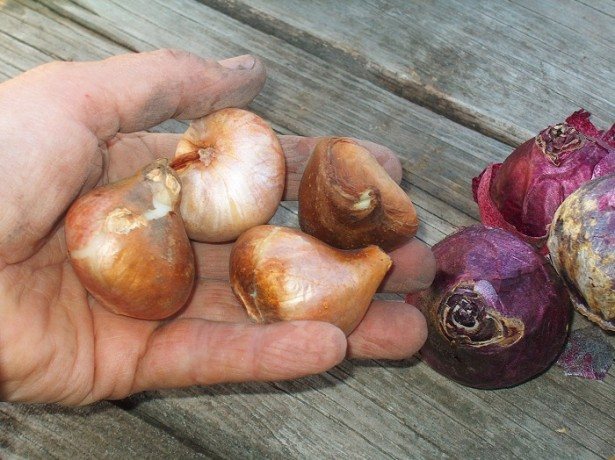

Peeled onions
Peeled bulbs keep well in wicker baskets or canvas bags. It is not necessary to wrap the planting material in polyethylene, all the bulbs will rot before spring.
How to store bulbs? Always warm and dry. Only under such conditions does the formation of a flower bud take place. If planting material is stored in a refrigerator or a damp basement, germination will deteriorate dramatically. And if the sprouts sprout, they are unlikely to please with their flowering.


Storing tulip bulbs
The optimum temperature for storing the bulbs is + 25 ° C. Gradually, the temperature can be lowered to + 14 ° C and even to + 10 ° C, but not lower, otherwise the flower bud will not form.
What to do with the "kids"? If you want to eat, you can separate small onions from the common "nest", but this procedure is left to the discretion of each gardener. Small onions, if they are rounded enough, can be planted in the fall along with other tulips. "Baby" in the first season will give one leaf and will increase the mass of the bulb, and the next season will bloom.
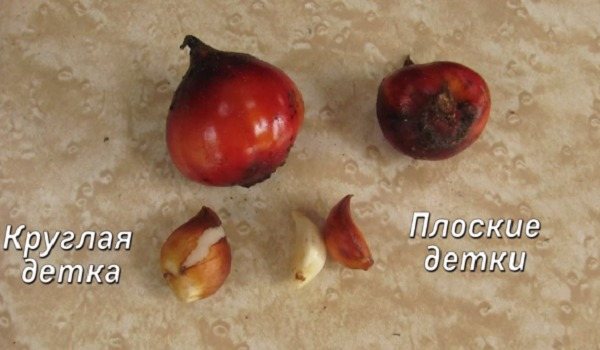

"Children"
If the "baby" is small and flat, it can also be transplanted, but it will bloom only after two years.
Tulips - care after flowering outdoors
These flowers are unpretentious and resistant plants, but improper care of tulips after flowering in the garden can lead to rotting of the bulbs, the formation of non-opening buds, and thinning of the stems. When flowers in the flowerbed begin to open one after another, the tulip needs special care - competent watering and regular loosening, pruning, feeding. Know when to dig up the bulbs after flowering and how to store them until next planting.
Do tulips need to be pruned after flowering?
When caring for tulips after flowering, it is important to prune correctly. Then you can easily propagate the species you like and grow healthy and strong bulbs. Pruning tulips after flowering:
- On the 4-8 day after the blooming of the petals (when they are about to crumble), the peduncle must be cut off. Such care is needed so that the plant does not waste energy and nutrients on the formation of seeds in the seed box.
- It is important not to touch the stems and leaves when pruning - if they are removed immediately after the flowers have faded, the bulb will cease to exist. When only the peduncle is cut off on the stem, the rhizome begins to gain mass intensively.
- If the tulip is cut for a bouquet, a couple of leaves should be left on the stem.
- Full pruning of the plant is done after all the foliage turns yellow and dries up.
Do tulips need to be watered after flowering?
With proper care, watering tulips after flowering, as well as during budding, should be abundant and regular. Moisture must penetrate to the entire depth of the roots, because they cannot extract it from the lower layers of the soil. On average, it is necessary to pour from 10 to 40 liters of water per 1 m2 of plot once a week. Watering abundantly and regularly should remain for another two weeks after the tulips have faded.
Fertilizing tulips after flowering
Fertilization of tulips after flowering is carried out no later than two weeks after the petals fall and the peduncle is trimmed. One top dressing is enough for the growth of a flower bud for the next season, which continues to form all summer, and the growth of a large bulb. Tulips are fertilized in this pore with potassium and phosphorus, during this period the plant does not need nitrogen. When choosing drugs, it is important to pay attention that they do not contain chlorine. Caring for tulips after flowering - how to feed:
- You can scatter dry dressing - and in an amount of 30-35 g / m 2, followed by watering.
- Or pour half a liter of wood ash with 5 liters of warm water and leave for 8 hours. Strain the liquid and dilute again with water 1: 5. Pour 2 tbsp into a bucket of working solution. tablespoons of superphosphate and water the plants.
When are tulip bulbs dug up after flowering?
With proper care, it is advisable to dig out tulips after flowering, especially fanciful varieties with fringes, with an interesting pattern every year. Simpler species (for example, ordinary red ones) can be disturbed once every 2-3 years. The bulbs of these plants go deep into the ground over time, and if left in the soil, there is a risk of infection. The flower itself will gradually crumble and lose its varietal characteristics. Tulip care - how to dig up the bulbs:
- They are dug up in June, 4-6 weeks after flowering. Until that time, the rhizome, together with greens, promotes photosynthesis and bulb growth, the appearance of "babies".
- To determine when to dig the rhizome, you need to watch the flower. Its leaves should wither and turn yellow, but not dry out completely. If you disturb the tulip early, the bulb will not have time to gain nutrients and will not delight you with a beautiful flower later. Late digging is fraught with the fact that the nest will dry out.
- To get the bulb, you need to dig in the bush, take out the “mother” with the “children”, cut off the roots and dried stems. The seed is laid out for a couple of days in one layer in a shaded place to dry out.
What to do with tulip babies after digging?
The tulip bulbs are sorted after digging, the nests are disassembled and calibrated (adults - separately, "kids" - separately). After drying, small heads should be immediately placed in a cool room with a temperature of + 15 ° C. In warm climates, "baby" can quickly dry out completely. In early August, such an onion can be planted in the garden for growing. If it is not possible to store the "kids" separately, they are planted immediately after separation, not forgetting to water and weed the plantings.
How to store tulip bulbs after flowering?
After drying, the planting material is etched in a solution of potassium permanganate, laid out in boxes and placed in a dark place with little or no light. At the same time, it is important to ensure proper care of tulip bulbs after digging:
- The air temperature in the room for the first 1.5-2 months should be in the region of +20 - 25 ° С, from the beginning of September it is lowered to + 15 ° С - ° С. This is necessary so that a flower bud can form in the bulbs.
- The room must be well ventilated so that the planting material does not rot and mold.
- Periodically, the bulbs need to be stirred and rotted, soft, defective ones should be discarded so that they do not infect the rest.
- Tulips are planted outdoors in autumn - from mid-September to early October. At this time, it is still warm, the plants will have time to take root, take root and winter well in the garden in order to paint it with bright colors in the spring.
What to plant after tulips?
Beautiful tulips adorn the garden but have a short flowering period. To keep the flower bed busy for the rest of the season, it can be planted with other plants. What to plant in place of tulips after flowering:
- Aster, salvia, marigolds, ageratum, lobelia, geranium, petunia. Their grown seedlings are planted right after the tulips, the plants will help keep the flower bed constantly in bloom.
- If tulip bulbs will be dug up every year, then preference should be given to perennials that will bloom right after them - hosts, astilbe, bruners, peonies, phlox. They will cover drooping and lost bulbous stems.
- The classic companions of tulips are forget-me-nots, viols, magrarites, they can be used to sow all the spaces between the bulbs.
- You can also grow vegetables after tulips. Carrots and parsley go well with bulbs. They are sown in the aisles of tulips in spring or before winter. When the tulip leaves turn yellow, the grown tops form a green carpet on the plot. After the onion, the flowers must be carefully dug out so as not to damage the vegetables.
Tulips are very beautiful during flowering, but this period does not last long. In just a few days, the flowers begin to wither and do not look so attractive. Not all growers know how to care for tulips after flowering, and make annoying mistakes when trying to immediately cut or dig up the bulbs.
The first secret is adherence to agricultural technology
Tulips are bulbous perennial flowers native to Mediocre Asia and spread almost all over the world. The largest number of new tulip varieties were bred in the Netherlands, and in fact in this country, in 1986, breeders received the first deep black flower.


Black tulips
It is also popular that the All-Russian Emperor Peter I loved to admire the flowering of tulips, walking along the streets of the capital he built.
Nowadays, all varieties of tulips are divided into 15 classes, among which flowers are simple and fringed, parrot, green-colored, lily-colored and other types that differ in the shape of the petals, their shade, as well as the timing of flowering (early and late).


Fringed tulips
The bulk of tulips bloom in late April - mid-May, and late flowers begin to decorate flower beds closer to the second half or cover of May. The growing season of plants, during which not only leaves, stems and buds, but also the main and daughter bulbs develop, takes three months. And the flowering of tulips ends during the month of June.
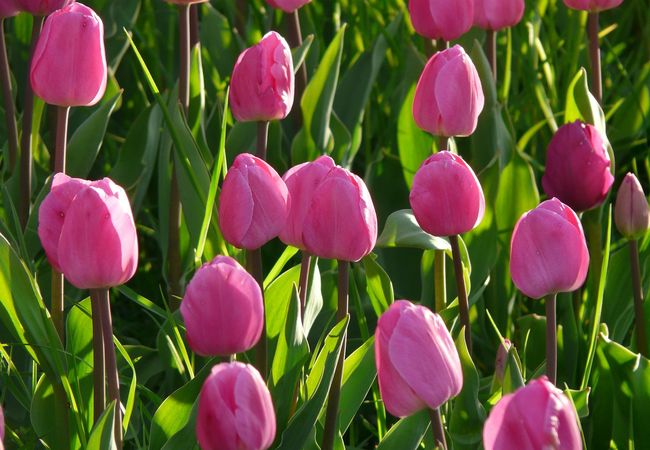

Tulips bloom until June
Growing features
| Features of the | Description |
| Landing | Tulips begin to be planted before winter close to the beginning of October. If the deadline has been missed, it is possible to plant the bulbs in the soil in April. The optimum planting depth for formed bulbs is 10-12 cm or two heights of one bulb. If it is not enough to bury tulips in the ground, they may freeze and not bloom in spring. |
| The soil | Flowers grow well on neutral and slightly alkaline, sandy loam and loose fertile soils. Tulips inevitably die in acidic soils. |
| Photophilousness | It is better to place flowerbeds in total in slightly shaded areas, for example, near the walls of the house. Here, the flowerbed will be protected from drafts and powerful winds that have a detrimental effect on plants. |
| Moisture-loving | Flowers are highly dependent on regular and quality watering.However, over-flooding the plants is dangerous - the bulb can rot. The most abundant watering is recommended during the flowering stage. |
| Top dressing | The flowers are fed three times, using both organic fertilizers (except for fresh manure) and mineral fertilizers, as well as superphosphate. The first time fertilizers are applied when shoots appear, the second - during flowering, and the last dressing is necessary for the paints a week after the petals wither. On a note! If the edges of the petals begin to turn blue, a potassium-phosphorus additive should be added to the soil. If the tulip petals lose their elasticity, are too narrow, the plants lack nitrogen. |
| Diseases | Flowers are susceptible to variegated viruses, various forms of rot, and tobacco necrosis. |
| Crop rotation | The worst predecessors for tulips are other bulbs such as daffodils and lilies. |
On a note! It is undesirable to grow tulips of various varieties on the same bed in order to prevent cross-pollination.
It is very important to care for the tulips diligently, water and prune them in time so that the bulbs have time to gain maximum nutrients and achieve sufficient development. Otherwise, the collapse of the bulbs and the complete degeneration of the variety are likely.
What to do after tulips bloom
Caring for tulips after flowering is pretty simple. The main rule is that flowers cannot be cut or dug out immediately. It is recommended to water and feed the plant well for several weeks. This feature is due to the fact that when the flower fades, tulip bulbs continue to accumulate nutrients for about three weeks. Digging up prematurely deprives them of this opportunity, so next year the tulip bloom may be less abundant.
After the final wilting, the peduncle is carefully removed. This will allow the plant not to waste energy on the need for seed ripening. It is impossible to cut the leaves immediately, since when they are removed immediately after flowering, the development of the bulbs lags behind. It is necessary to ensure that the tulips are adequately watered and fertilized.
At this time, many gardeners have a desire to remove yellow leaves, but this should not be done. Experienced gardeners recommend simply pressing them to the ground or planting perennial plants with tulips to give the flowerbed an aesthetic appearance during this period. You can decorate the flower garden during this period, having previously planted daffodils or phloxes with tulips.
Within a few weeks, the tulip leaves will dry out naturally and can be cut off. In order not to lose the place of planting flowers after the leaves have dried, it is recommended that you first make guide marks by which you can easily find it.
Seventh secret - fighting disease
Plant diseases are best prevented. For this, the planting material must be soaked in a solution of the "Fitosporin-M" preparation before planting in the ground or before storage.
What to tinker if you could not avoid diseases?
| Name of the disease | Symptoms | Control methods |
| Necrotic disease tulips | There are brown spots on the bulbs. | 1. Dig up a plant with a clod of earth and burn it. 2. Disinfect the soil. 3. Do not plant tulips in that place for several years. |
| Snow white rot | White bloom that turns brown over time. | 1. Dig up the bulbs and burn them with a lump of soil, powder the ash into the holes. 2. Dilute formalin with water to a concentration of 15%, spill soil in the amount of one bucket per square meter, serve the treated soil with a film. |
| Fusarium rot | Brown spots develop on the bulbs. | 1. Remove the affected bulbs. 2. Before planting a pull, treat the remaining seed with a solution of the drug "Fundazol" or soak the bulbs for 8 hours in an eleven percent formalin solution. |
| Variegated | First, white stripes appear on the petals, and then on the leaves. Then the plant inevitably shrinks and dies. | Sick plants must be dug up and burned without pity. It is better not to plant new tulips in the same place until six years old. Do not forget to weed flowers and cultivate with aphids and other parasites - carriers of viruses that are harmful to flowers. |


How to deal with aphids
Do daffodils need a haircut?
Diversified in shape, size of flowers, color and, moreover, resistant to adverse conditions, unpretentious daffodils inhabit many gardens near Moscow. Lush May bloom pleases summer residents, but what to do with the leaves after it ends? Cut or not?
We proceed from the nature of the plant. The root system of the daffodil is perennial. The roots live off the bulb, which grows from the inside and on which, in turn, babies appear, giving life to a new plant. The more nutrient reserves the bulb retains, the more energy the plant will have for flowering next year. And this process of food accumulation is directly related to the leaves. As long as the leaves remain green (sometimes even until August), there is an accumulation of nutrients in the scales of the bulbs.
Hence the conclusion: you cannot cut the leaves of daffodils immediately after flowering. For a better future, you will have to endure a not-too-pretty present. Moreover, try to maintain soil moisture both during bud formation and during flowering, up to the wilting of the leaves.
So that drying leaves do not spoil the harmony of your flower garden, consider this feature of bulbous plants even when planting and combine daffodils with other perennials: daylilies, hosts, heucheras, astilbe and brunners, which, growing by the summer season, will cover the withered foliage with their green "wings".
There is an interesting and very effective design technique: slightly drooping daffodil leaves that have fallen to the sides are collected, like hair, in a bun and braided "braids", which are then laid on the ground. And the beauty of the garden, and the benefits of the plant.
Is it necessary to cut tulips, daffodils and hyacinths during flowering, thereby providing
To form stronger, developed bulbs, buds and flowers are cut on many bulbous plants. Inflorescences of tulips, daffodils, hyacinths are cut immediately after flowering to prevent excessive plant depletion.
If possible, it is better to cut off flowers from faded tulips, daffodils, hyacinths, if you do not plan to remove a new variety from seeds. Then the nutrients will completely enter the bulb and contribute to its growth and the establishment of a new flower bud for the next year.
Not necessary. they must be cut off when they begin to bloom. the bulbs will have time to ripen before the end of summer.
It is enough not to leave the seed pods, and if you cut the flowers, then leave at least two leaves.
The main thing is not to cut the leaves.They feed through them
It is advisable to cut after 4-5 days of flowering. But you can simply cut off the seed pods.
Quite right. After flowering, nutrients from the leaves are released into the bulb. All leaves do not need to be cut off.
I never cut off at all, cut off as correctly said after flowering the seed pods, and the bulb will gain strength from the leaves
indoor-plants-
Dry method
If long-term storage or transportation is required, then the flower can be saved from withering in a dry way. For example, tulips that are cut in Holland can withstand long travel and store storage. To do this, growers adhere to the following rules:
- 1Plants should be wrapped in damp newspaper, paper and stored in the refrigerator. It is important that the buds do not touch.
- 2 The temperature cannot exceed 4 ° C, and the humidity should be practically 95-98%.
- 3If food is stored in the refrigerator, it is recommended to put the bouquets in a box, pre-lubricated with paraffin.And in the container you need to leave a little free space, as the cut plant continues to develop.
- 4 Delivery of plants from the refrigerator, they must be left for a couple of hours at normal temperature. Then, if you do not plan to put the plant in a vase, you need to update the cuts, wrap the flowers with dampened paper and put them in a box.
Light should not fall on the tulips, otherwise the stem will bend and it will be impossible to fix it. Dry storage helps save the flower from wilting for 14-20 days. This is important if the plant needs to be transported for sale or stored for a long time before donating to someone.
2 Preparation of planting material
Another nuance in growing tulips: they are dug up annually and transplanted to a new place in the fall. The exception is red tulips, but they begin to disappear after a certain number of years. In the southern regions, where at the beginning of April the air warms up to 20 ° C, gardeners transplant the bulbs every 2-3 years.
A few words about why tulips need an annual transplant. Their bulbs tend to go deep into the ground, and deeper every year. To germinate, they require a lot of nutrition and strength, and as a result, they may die. Remember rule number 3: tulip bulbs need to be dug up annually.
One more question that may arise when growing tulips: how to find the location of the bulbs? Indeed, after the foliage dries, the bed is leveled. But tulips can be distinguished a little earlier with flags or other marks.
The best time to harvest bulbs is in the middle of summer. Can you determine for yourself if they are ready? You need to dig out 1 copy and examine it: it should be covered with brown scales and have roots.
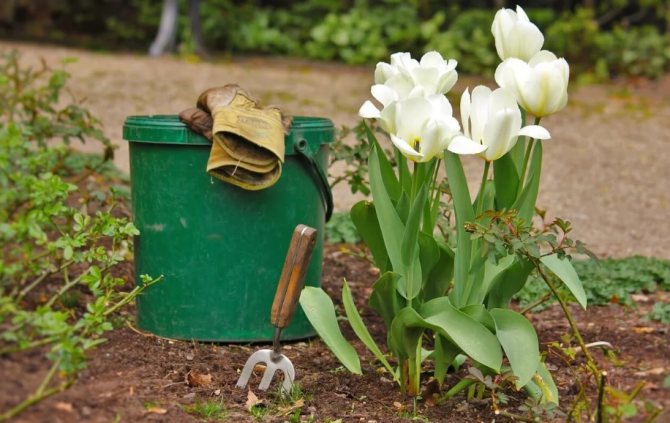

Now they are preparing several cardboard boxes, where they will put onions, leaves with an inscription of varieties, and a container with a disinfecting solution (you can use 5% potassium permanganate). Then you can get to work. Let it be not too cloudy outside, but not sunny either. With a garden spatula, they carefully dig out the bulbs and discard the weak, small and damaged ones.
Tulips are often presented to the beautiful half of humanity on March 8, they are, as it were, a symbol of spring, femininity, tenderness. But what if the flower was presented in a pot? It can be saved and planted in the fall in a flower bed. Care after flowering will be the same: regular watering until the leaves turn yellow.
Rules for choosing tulips in the store
If you buy a bouquet in a store, you can find out, check their freshness. How is this possible? First, ask the seller when they went on sale and for how long they are in the store. You can also specify where the flowers are stored. It is advisable that they are in a cold room, where the sun's rays do not penetrate. Next, you need to inspect each copy - if the flowers are tightly wrapped in cellophane or opaque paper, ask the florist to unfold them.


If the flowers are tightly wrapped in cellophane or opaque paper, ask the florist to unfold them
Outwardly, they should look exactly the same as those that are plucked from the garden (we discussed this issue above). If an elastic band is worn on the buds, this may indicate that the seller is worried that the petals will fall off.
Some unscrupulous sellers disguise stale buds among artificial decorative elements in the form of multi-colored skewers, decorative wire, colorful paper. We recommend that you always carefully examine such bouquets.
How to feed tulips in spring
Caring for tulips in spring involves feeding them, since during the growing season they need to provide a balanced diet for good flowering.
Use only easily soluble fertilizers for feeding tulips, since due to the underdeveloped root system, they absorb only those fertilizers that are close to the roots.
I would recommend that you feed your tulips with liquid universal fertilizers that are suitable for all flowers (and for indoor ones too).
You will see how your pets will react to feeding with their fast growth and great flowering.
In the spring, as soon as the snow melts and the first sprouts of tulips appear, dry fertilizers with prolonged action can be used. Spread this fertilizer on the ground between the plants. With each watering, some of the nutrients will get to the roots of the tulips.
A good fertilizer for these purposes, in my opinion, is Kemira-flower. It contains 17% nitrogen, 10% each phosphorus and potassium and a number of trace elements. And so, as tulips need a lot of nitrogen during their growth.
When the buds appear, you need to carry out a second feeding. At this time, the need of tulips for phosphorus and potassium increases for the formation of a flower stem and flower. These requirements are met by the fertilizer Kemira Lux (dissolve 1 tbsp. Spoon in 10 liters of water and feed once).
When the tulips bloom en masse, you need to feed them a third time. This top dressing is already aimed at ensuring that a good bulb is formed in the future.
This time, you need to feed only with potassium-phosphorus fertilizers in a ratio of 1: 1.
How do you dig up and store the bulbs?
Tulip bulbs must be dug up every year without leaving them in the ground for the winter. This will improve the quality of the seed and prevent infection with infectious diseases. The bulbs should be dug out after pruning in late June or early July. In this case, first, the early varieties of tulips are dug up and only then the later ones.
To dry out the bulbs faster, they are removed in sunny, dry weather. After digging up, the resulting material is carefully examined. Well-developed bulbs should have healthy roots and brown scales. The injured and sick must be thrown away immediately. Then the selected specimens are dipped for several minutes in a 5% solution of potassium permanganate and dried.
Before planting in the open field for storage, the bulbs are transferred to boxes with a mesh bottom so that the air can circulate better. Seed material is placed in two layers. Prepared boxes are placed in a dark, dry place with good ventilation. The air temperature in the first month in this room should be from +23 to +25 degrees. In the second month, the temperature is lowered to +20 degrees, and before planting on a flower bed, it should be +17 degrees.
When storing bulbs, do not allow sudden changes in temperature, this can lead to the appearance of "blind" buds.
Ready bouquet
The most durable will be a bouquet grown immediately in a glass vase. For forcing without soil, bulbs marked “for winter forcing” will be needed. Sequencing:
- 1First, the bulbs should be kept in a cold place (on the balcony or in the refrigerator) for 2-3 months.
- 2Then you need to prune the roots, leaving about 2 cm.
- 3In the vase you need to put a handful of glass balls and place the carefully washed onions on top, you can add some balls around them.
- 4 Then pour water into the vase, making sure that the liquid level does not reach the bulbs.
- 5Place the vase in a bright, but not hot room.
- 6Water during growth and flowering should be periodically added.
The finished bouquet will grow immediately in a vase and will not fade for a long time.
Tulips care and cultivation tips for summer residents
It is impossible to imagine any garden in spring without tulips. With their delightful variety of varieties, they bring warmth and color to a barely revived flower garden after winter. The tulip can rightfully be called the king of the spring garden.
It is completely easy to make friends with him, but, as a rule, the more refined the shape of the flower, the more fastidious it is. Many growers believe that Dutch growers specifically treat the bulbs with drugs to enhance their division. Accordingly, such bulbs can please with high-quality flowering only in the first year, and then again you have to acquire new planting material.
Is this really so or the reason is not acclimatization of plants in new unusual conditions. However, Dutch tricky bulbs do, after flowering, disintegrate into babies. Such bulbs must be dug up and treated with a fungicide and insecticide, dried and planted in autumn for growing.
During growth, it is necessary to carefully monitor the development of the flower. If a plant is obviously lagging behind in growth and looks unhealthy, then it is better to dig it up together with the bulb and the earth around it and burn it. It is also worth doing if a blooming flower has a pattern uncharacteristic of this variety. This can be a signal of a dangerous viral disease.


After cutting each tulip, the knife must be disinfected in a manganese solution, since dangerous diseases can be transmitted through the plant sap. It is advisable to cut it so that as many leaves as possible remain on the flower, so that the bulb will be able to feed on it in the future. If tulips grow in a composition with other flowers, then it is very important to remove withered foliage in a timely manner. This is due to the fact that rot spreads through wilted leaves in damp weather, which can infect nearby growing flowers.
Tulip irreplaceable flower in the garden in spring
They look great in combination with roses and lilies blooming in summer. Their location in the flower garden does not matter, since they do not tend to turn their heads towards the sun. Tulips will play with completely unusual colors if you plant them in front of conifers. Tulips look much better in group plantings. Therefore, in the spring you need to pay attention to the gaps and in the fall to annoy the bulbs there.
Method for storing cut tulips without water
Regardless of whether you bought a bouquet in a store or cut flowers from a garden, you need to try to make it stand as long as possible. How can you extend the life of a bouquet? In this case, you will have to send it for storage.
Method 1. Store tulips without water. You may be surprised, but these flowers can stay fresh for a long time without water. All you need is to create appropriate conditions for them. Proceed as follows:
- After you cut the flowers, pluck the large, withered leaves from the bottom of the stem.
- Take your pruning shears and trim the stems around the edge.
- Place tulips in a bunch (5-15 pieces each).
- All heads should face the same direction. Wrap them in damp cloth or paper. In no case do not take polyethylene for this. Keep in mind that even after you have cut the flowers, their slow growth does not end, so do not wrap them too tightly.
The third secret is the correct feeding after flowering.
When the delicate petals fall off, the bulb begins to actively accumulate nutrients for further development and formation. Therefore, in the period after trimming the peduncles, it is necessary to apply 30 grams of Superphosphate fertilizer for each square meter of the flower bed.
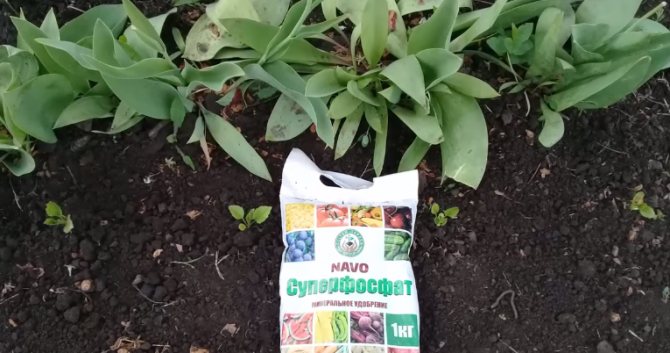

Fertilizer granules just need to be scattered closer to the plant roots, and then the soil is loosened.
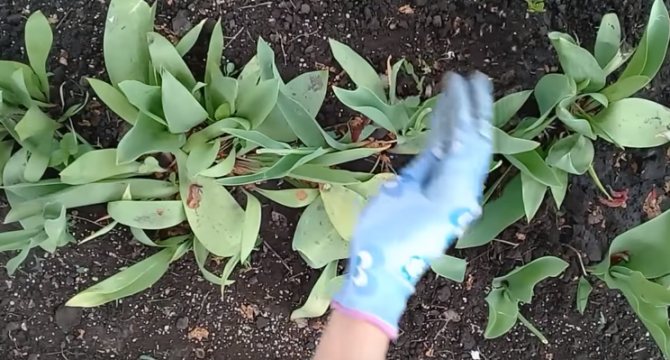

Very important! After flowering, it is forbidden to feed tulips with nitrogen and chlorine fertilizers. In addition, it is important to have a sense of proportion - you do not need to overfeed the flowers so that the formation of the bulbs does not drag on.
Nature will give the right answer
To correctly answer this question, it is worth observing how tulips grow in nature.Once you understand the natural rhythm of wild flowers, you can easily determine the ideal time to plant your bulbs.
Most varieties of tulips are native to Central Asia. As a rule, these plants are found here in sandy and stony deserts, in steppes, crevices of rocks, on scree, in arid mountain areas and foothills. It is worth noting that in early spring these areas simply amaze with their unique beauty. After all, it is at this time that tulips bloom. Photo confirmation of this. Flowers cover the deserts and slopes of the mountains of Central Asia with a variegated living carpet.
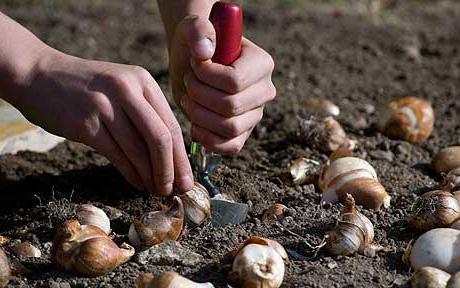

When the chill of spring turns into summer heat, tulips wither and dry up. All the life of these plants is concentrated in the bulb. Tulips go deep into the ground. When autumn comes with its coolness, the plant forms new roots. This will allow it to bloom in the spring immediately upon awakening. As you can see, tulips bloom in their natural environment only after winter. Colds are necessary for the plant to collect useful components in the bulb, which have a great influence on processes such as germination and flowering. Do you think tulips can be planted in spring? Or should we wait until autumn?
How to store cut tulips
Immediately after cutting, it is recommended to put tulips in water and leave in a cool place. Then you can resort to the dry method, or leave the flowers in the water.
If the buds began to bloom ahead of schedule, then this process can be suspended by placing the tulips in a container with water and snow, and leaving it in a cold room (+2 degrees) for 10-14 days.
Storage in water
How to keep cut tulips at home? The easiest way is to place the flowers in water.
But this method also has its own secrets that will help prolong the stay of fresh flowers in the room. (picture 1):
- It is worth paying attention to the cut line. If it is straight, then you need to make it oblique.
- Before placing the flowers in the vase, make holes (scratch) at the bottom of the legs. This will help the plant get the moisture it needs.
- Transferring the flower to the vase, pinch the cut with your finger.
- Remove the leaves at the bottom of the stem to prevent premature water spoilage.
- Add a piece of charcoal to the water, or prepare a light solution of potassium permanganate for the flowers.
- You need to change the water in the vase daily. At the same time, it should be cold, even pieces of ice floating in it will not be scary.
- You can feed the flowers with a sugar solution (10-20 g per 1 liter of water) or regular aspirin (1 tablet per vase).
- Even cut flowers continue to grow stems and need to be shortened from time to time.
- Place the flower vase in a bright spot. Make sure that it is not blown through by drafts.
- It is not recommended to place flowers of different types in the same container.
- For the best preservation of the bouquet, it is necessary to ensure that there are no already wilting flowers nearby, since the gas released during this has a negative effect on living plants.


Figure 1. Correct placement of cut flowers in the water
If the flowers have begun to fade, wrap their stems tightly with a damp newspaper, tighten with an elastic band and immerse them in warm water until buds for several hours. It is better to cover the buds with foil and turn on a bright light above them. The water will give the stems strength, and the light will lift the flower heads.
The author of the video will tell you how to preserve cut tulips for a long time.
Refrigerated dry storage method
An alternative to storing in water is to store flowers in the refrigerator. After cutting, wrap with damp paper and place in the refrigerator.
At the same time, the following rules are observed (picture 2):
- The wrapped buds should not touch each other.
- The temperature of the refrigerator compartment should be no more than 3 degrees, while the humidity should be high (97%).
- It is necessary to isolate plants from all food in the refrigerator. For this, the flowers are recommended to be placed in a box with walls covered with paraffin. It helps to retain moisture.
- As the crops continue to grow in the refrigerator, it is necessary to leave some free space in the box.
- It should be dark in the refrigerator, otherwise the stems of flowers will begin to bend towards even a small source of light.


Figure 2. Preparing plants for storage in the refrigerator
The dry storage method makes it possible to leave flowers alive for about 2 weeks. After removing the tulips from the refrigerator, they are allowed to adapt to the environment, then the sections are renewed, wrapped in paper again and the stems are placed in water. After half an hour, the paper can be removed.
When and how to plant tulips?
You can plant tulips in the ground already in September, look at the weather, if the constant air temperature is set within 5 - 7 ° C, then you need to plant.
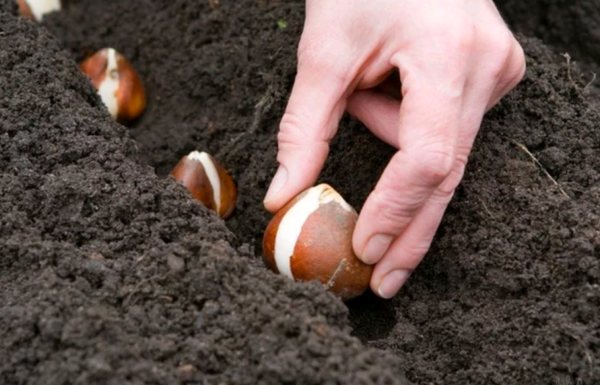

This requires:
- The prepared seed is again treated with a 5% solution of potassium permanganate;
- Choose a new planting site, you cannot plant flowers in the same place where they grew before. The landing area should be well lit and windless;
- Dig a furrow 15 cm deep for large bulbs and about 6 - 7 cm for children, if you plan to plant several rows, the distance between them should be at least 30 cm;
- Add sand and wood ash to each furrow, the soil becomes loose from this, and ash is also an excellent fertilizer. Never use fresh manure as fertilizer for tulips, the bulb of the plant can get burned and die;
- Choose the same size bulbs for planting in one row, because the smaller the bulb, the smaller the groove it needs, also keep in mind that the babies will not bloom in the first year after planting;
- The distance between the bulbs in the furrow should be 10 - 15 cm; the larger the bulbs, the greater the distance between them;
- Before planting flowers, the grooves must be shed with water. The planted plants are also watered, then the earth envelops the bulbs better, and they take root better.
Preparing your bulbs
If you use bulbs obtained from your own flower garden as seed, they should also be pre-planted. Before planting tulips in spring, they must be subjected to the following procedures:
- The bulbs dug out of the flower bed must be peeled from the tough outer skin and the bare bulb must be examined for defects and diseases. In addition, the "naked" bulb is able to more efficiently obtain nutrients from the soil.
- Further, the planting material is degreased and disinfected. To do this, you can use the already mentioned potassium permanganate solution or a special preparation. An alternative to chemistry is celandine solution, in which the bulbs should be kept for about half an hour. This will help kill fungi and bacteria that can damage the bulbs.
- When planting bulbs in pots, it is recommended to use only a clean substrate, since soil taken simply from a flower bed may contain putrefactive bacteria. By the way, it is also recommended to completely replace the topsoil in the flowerbed itself for the same reasons.


Dig to plant again in the fall
According to science, it is recommended to dig up tulips bulbous plants: varietal every year, and "simpleton" after 2-3 years. What happens if you don't? Very terrible - nothing, the flowers will not disappear, except that the hybrids will begin to shrink and degenerate soon.
But we don't need that. So we are digging out tulips to maintain the varieties (in vain they bred, bought), and also in order to avoid the consequences of the following plan:
We start digging with early varieties, and then move on to late tulips.
Planting tulips in autumn
A bed for tulips can be prepared in advance by adding humus, a little ash or fertilizers (superphosphate, potassium salt) for digging. It is better to choose another place, but if it is permanent, then it's okay, we dig up and fertilize the ground every year.
The day is chosen dry, the weather is already cool, and the soil temperature should be 8-10 degrees.
We mark the rows, they differ for bulbs of different sizes. The distance between the rows of large onions is 20 centimeters, for small ones - 10-12 cm. The planting depth is chosen based on three sizes of the bulb. So we make trenches according to the size of the calibrated material.
Water the holes, put tulip bulbs in them and sprinkle with earth on top. Additional watering will have to be done in 4-5 days, because intensive rooting begins. And before freezing, you can mulch the plantings with humus, peat or compost.
Tulips do not need shelter, the bulbs of a frost-resistant culture will undergo stratification (hardening) during winter in order to wake up with the first rays of the spring sun and start growing.
Landing in the ground
Ideally, tulips are planted in the soil in the fall., in late September - early November. Spring disembarkation is also practiced, in April. But then the tulips will bloom much later, because they will need about three weeks to root. It is advisable to change the planting site every year so that pathogens do not accumulate in the soil.
Where spring flowers will grow, moisture should not stagnate. The future flower bed is prepared in 2 weeks so that the earth settles evenly. The bed is dug to the depth of the shovel bayonet and compost, ash or superphosphate are added. Lime if necessary. On clay soils, the introduction of peat is encouraged. In the absence of rain, the area is spilled with water.
Before planting, the bulbs are sorted out again and disinfected in a solution of potassium permanganate. The planting depth of the bulb is three times its height. For large specimens, the distance between the bulbs is maintained at 15 cm, for medium ones - 10 cm, small ones - 5 cm. 25–30 cm are left on the row spacing.
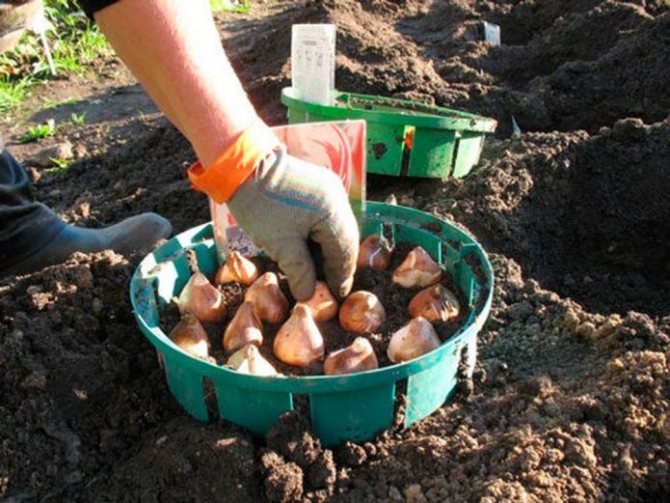

Advanced flower growers plant tulips in special baskets for bulbs, they are very easy to dig
Do not cover the flower beds with organic matter so as not to attract rodents. With the onset of unforeseen frosts, agrofibre is spread on the flower bed, which is pressed by boards.
On the advice of an experienced grower, when planting, I put a handful of sand mixed with ash in the hole. I put an onion on this "hill" and cover it with earth. Now the loss of tulips from various rot on my heavy loam is minimized. And the bulb comes out larger, due to the fact that the sand loosens the soil and the roots develop freely.
Top dressing immediately after flowering, disinfection of bulbs and warm storage with a subsequent decrease in temperature - these are the three whales of the grandiose spring flowering of tulips.
Tulips are one of the earliest spring bulbs that adorn the flower bed with a bright riot of colors. Caring for these plants is needed not only during the budding period - after it is over, they also require attention. Only in this way can you achieve high-quality re-flowering, preserve the health and strength of the tulip.


Planting in spring: features
So, can tulips be planted in spring? Many argue that you can, but you shouldn't.What if all the autumn planting dates have passed, and you need to plant the bulbs? Of course, plants planted in spring will also sprout and bloom. They bloom, however, a little later. You can accelerate the growth and blooming of buds by resorting to simple techniques. Of course, proper grooming also matters.
Before planting tulips that have lasted all winter or were recently purchased, place the tubers in the refrigerator overnight, but not in the freezer.
The next day, dilute the pink potassium permanganate solution and gently rinse the bulbs. Only then can you plant tulips.
How to plant tulips correctly: preparing a garden bed
So, we plant tulips in the spring. First of all, you need to prepare the area for planting the bulbs. You can begin to prepare a bed for tulips as soon as the snow melts, and the soil will not be so dirty.
If the bed was prepared in the fall and there are no perennial weeds on it, then you do not need to dig up the soil. Just loosen it to a depth of 5 centimeters. This can be done using a conventional hoe or Fokin's flat cutter. After that, make holes or grooves in the ground.
If the bed is still overgrown, then dig it up. At the same time, try to choose the roots of perennial grasses as carefully as possible. If the bed was prepared in early spring, and you decided to plant the planting a little later, and it was overgrown with small weeds, then you should not dig up the soil anymore. Just loosen the soil.
What to do with the bulbs during storage
Dug up onions in a brownish-yellow peel are laid out under a canopy for ventilation, where it is warm and there is no access to direct sunlight. After a few days, you can lightly cleanse the soil and loose skin (you do not need to tear it off specially). We leave it like this for another 20 days.
Then the storage temperature drops a little, well, this is what happens, because August is outside. During this time, and it is still far from planting, it is necessary to sort the planting material. We put large, medium and small onions in different containers. By varieties, they are already divided, probably. What is it for?
The fact is that when planting, we will plant bulbs of different sizes at different depths: large ones are lower, and small ones are superficial.
Advice! Planting bulbs of different sizes on separate rows will refine the beds, give them an aesthetic appearance, because the flowering of one-caliber material will occur simultaneously.
By mixing large and small tulips, you will delay the flowering of the latter, if at all due to lack of lighting.
The bulbs are stored and dried in summer until planting, which is carried out in September-October.
Storage
During summer storage, the bud and buds of future bulbs are finally formed. In order for the aging process to take place correctly, they are first kept for a month at a temperature of about 25 ° C in a well-ventilated room. The optimum humidity is 60–70%. In August, the temperature is lowered to 20 o C, in September and further - to 15 o -17 o C... If these rules are not followed, tulips may not bloom or give "blind" buds.
Periodically, the planting material is examined and discarded by sick or moldy ones. Most often stored tulips are affected by gray rot and fusarium. At the first disease, the bulbs become covered with a gray coating and gradually rot. In the second case, brown spots with a brownish border are formed, the bulbs exude an unpleasant odor and also decompose. If the lesion is small, the rot is cut off with a sharp knife, the onion is pickled, as usual, then sprinkled with ash and dried.
Read also How to properly peel a coconut
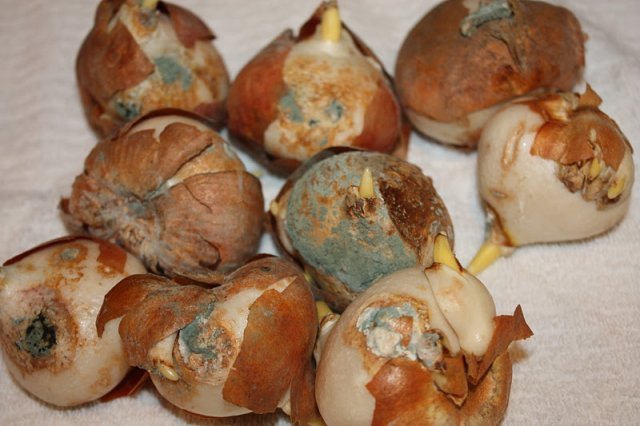

Poorly dried and not disinfected bulbs are often affected by gray mold


